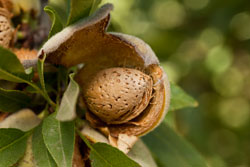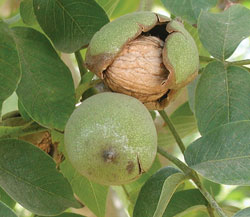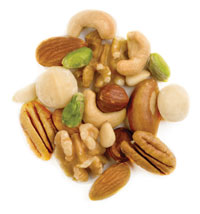Almonds & Walnuts: Shaking Out Quality
FOOD SAFETY & QUALITY
 Besides providing sensory satisfaction—as indicated by their popularity around the world—nuts also provide high nutritional value. Although peanuts, sunflower seeds, and pumpkin seeds are considered snack nuts, the real nuts are tree nuts: almonds, Brazil nuts, cashews, hazelnuts, macadamia nuts, pecans, pine nuts, pistachios, and walnuts. The United States trails only China in world tree nut production but is the world’s largest exporter of tree nuts. California produces almost 90% of U.S. tree nuts. The Agricultural Marketing Service of the U.S. Dept. of Agriculture (USDA) has established quality standards for grades of nuts, both in the shell and shelled.
Besides providing sensory satisfaction—as indicated by their popularity around the world—nuts also provide high nutritional value. Although peanuts, sunflower seeds, and pumpkin seeds are considered snack nuts, the real nuts are tree nuts: almonds, Brazil nuts, cashews, hazelnuts, macadamia nuts, pecans, pine nuts, pistachios, and walnuts. The United States trails only China in world tree nut production but is the world’s largest exporter of tree nuts. California produces almost 90% of U.S. tree nuts. The Agricultural Marketing Service of the U.S. Dept. of Agriculture (USDA) has established quality standards for grades of nuts, both in the shell and shelled.
Almonds
The United States produces more than 80% of the world’s almonds, and California is the only state that produces them commercially. Almonds have a tough gray-green outer hull covering a hard shell, within which is a kernel covered by a thin brown skin. The almonds are harvested in the fall by mechanically shaking the tree and collecting the nuts. After twigs, leaves, and other debris are removed, a series of shear rollers mechanically remove the hull from the in-shell nut. The hull and foreign material are then removed with vibratory screens and air separation. The nuts are then passed through a series of shear rollers to crack the shell, and the shells are separated from the kernels by vibratory screens and forced air. The kernels are sized by passing them through a series of perforated screens with holes of increasing size, sorted electronically and by hand to remove defects, and graded.
Tim Birmingham, Director of Quality Assurance & Industry Services at the Almond Board of California, said that the almond industry continues to make research investments to maximize quality at the orchard level as well as throughout processing and distribution. Several projects are underway to better understand the impact of moisture and temperature on almond quality and shelf life, he said, and results of this research will enable the almond industry to make better recommendations on usable shelf life of the product stored under various packaging and climate conditions.
Tests such as peroxide value and free fatty acid content are currently used as indicators of quality, he said, but studies funded by the Almond Board are being conducted by Alyson Mitchell, Professor and Food Chemist at the University of California, Davis, to define a range of chemical markers that can be used to identify product quality defects, such as oil oxidation/rancidity, in less time than traditional methods. More than 43 volatile compounds have been identified, and some of those compounds look promising. The Almond Board will continue to fund further investigations of these compounds for future use in quality/sensory analysis of almonds, Birmingham said.
He added that product testing alone does not provide the level of safety that the almond growers and processors demand for their customers. Since almonds are exposed to the environment during the growing season and harvest, there is the possibility that they may come in contact with microorganisms. The almond industry has made a significant investment in understanding this risk by funding a study over an eight-year period to examine the prevalence of pathogens such as Salmonella in almonds. The study was conducted by Linda Harris of the University of California, Davis, and DFA of California, and positive samples were found in just under 1% of the approximately 14,000 samples analyzed. Since the prevalence level is low, product sampling is not an ideal mechanism to rely on for food safety, Birmingham said. To have a reasonable level of assurance that finished product testing would reject all contaminated lots, a large number of samples would have to be analyzed, and even then there would be a risk of falsely accepting a lot based on lack of positive findings.
Rather than rely on product testing, which may yield false assurances, the almond industry has implemented a number of food safety programs across the supply chain to ensure the safety of almonds, Birmingham said. These include Good Agricultural Practices (GAPs) in the orchards to reduce the risk of contamination; Good Manufacturing Practices (GMPs) and Pathogen Environmental Monitoring (PEM) to control contamination in processing plants; and preventive controls such as the mandatory program for pasteurization of almonds sold within the United States, Canada, and Mexico. The Almond Board implemented its mandatory pasteurization program in 2007, and since then more than 170 processing machines have been validated as delivering a minimum fourlog destruction of Salmonella on almonds. Annual audits are conducted by the Almond Board and the USDA to ensure that the equipment and operations used meet the critical factors established during validation.
Birmingham said that the almond industry is well-positioned to address the proposed Food Safety Modernization Act rules—much of the work the industry has done with its pasteurization program has been based on identifying hazards and the appropriate controls to address them at both the orchard level and the processing level. He added that the almond industry intends to remain proactive in improving its quality and safety programs and to continue to invest in research and technologies to identify and eliminate defects before the products enter consumer channels.
Walnuts
The United States is the leading commercial producer of English walnuts. California produces 99% of the walnuts grown in the United States, and exports account for nearly 58% of the crop. The walnut kernel consists of two lobes covered by a thin, light-brown skin within a hard round shell covered by a green husk. Harvesting is done when the husks start to split. Machines shake each tree to release the husk and nuts, and mechanical harvesters pick them up. The hulls are removed using water flumes and mechanical force (squirrel cages) at specialty firms called huller/dehydrators. Then the walnuts are mechanically air dried to 8% moisture to prevent deterioration. Unless they are to be sold in the shell, the walnuts are mechanically cracked, and the kernels are separated from the shells by air blowers, sorted by size, and graded according to USDA standards.
--- PAGE BREAK ---
Carl Eidsath, Technical Support Director at the California Walnut Board, said that the shelled kernels may be pasteurized as an optional step before distribution. Walnuts are very sensitive to heat and can’t be heat pasteurized like almonds and pistachios since the omega-3 fatty acid alpha-linolenic acid rapidly becomes rancid after exposure to the elevated temperatures needed to pasteurize tree nuts. Pasteurization using the fumigant propylene oxide was validated as a kill step in 2012 and approved by the U.S. Food and Drug Administration. Research on technology to pasteurize walnuts without damaging them is ongoing.
 Eidsath said that many physical tests are conducted on shelled walnuts; color and size perhaps are the most important. Microbial testing has also become very common in the past several years. Pathogen clearance for Salmonella and Escherichia coli O157:H7 has become a nearly universal requirement, with product held until testing is complete. Each lot of shelled walnuts is certified by an independent testing laboratory. Other tests are aerobic plate count, coliforms, generic E. coli, and mold. He added that walnuts have benefited from advances in rapid microbial testing that lead to shortened hold times.
Eidsath said that many physical tests are conducted on shelled walnuts; color and size perhaps are the most important. Microbial testing has also become very common in the past several years. Pathogen clearance for Salmonella and Escherichia coli O157:H7 has become a nearly universal requirement, with product held until testing is complete. Each lot of shelled walnuts is certified by an independent testing laboratory. Other tests are aerobic plate count, coliforms, generic E. coli, and mold. He added that walnuts have benefited from advances in rapid microbial testing that lead to shortened hold times.
Like the almond industry, Eidsath said, the walnut industry conducts Salmonella and E. coli O157:H7 prevalence studies and recently finished the third year of testing walnuts. For reasons not yet understood, walnuts have one-tenth the prevalence of these pathogens compared to almonds and pistachios. Walnut growers follow established GAPs in the orchards, and GMPs and Hazard Analysis and Critical Control Point (HACCP) principles are components of the food safety program in the walnut industry’s 85 processing plants.
The most recent advances regarding quality testing of walnuts, he said, relate to inspection by advanced technology to remove shell fragments and other foreign matter. Tiny shell fragments that inspectors find difficult to see are now easily detected by in-line laser and optical sorters.
Moving Back up the Supply Chain
Diamond Foods, one of the top three nut retailers in the United States, markets a variety of nuts under its Emerald brand, obtaining its almonds and walnuts from the United States and its other nuts from the United States and other countries.
Rob Shank, Director of Material Management, said that when a shipment arrives from its suppliers, Diamond Foods quality assurance personnel take a sample to verify quality and make sure that the nuts meet USDA standards. If the nuts are going to be further processed, they go straight into a cold box to preserve freshness and quality. Otherwise they are sterilized and then put into the cold box. Processing prior to packaging with a validated kill step will take care of microbial concerns. Then the nuts are packaged, cased, and distributed to the supply chain. Shank said that Salmonella contamination has been a problem from time to time in the nut industry. The biggest domestic problem is contamination from environmental conditions in the field that are many times beyond the control of the growers. In developing countries with underdeveloped infrastructure and sanitation programs, nuts are often manually processed, which has the potential for contamination. To avoid problems with Salmonella, Diamond Foods either sterilizes the nuts or uses processes with a validated kill step.
HACCP programs and GMPs are followed by the nut industry to maintain cleanliness, he said, and critical control points are being identified along the total supply chain from field to table. GAPs and GMPs are being introduced at each phase, specifically upstream of the end processor, to minimize contamination.
 Books on Nut Safety and Quality
Books on Nut Safety and Quality
Tree Nuts—Improving Safety and Quality will be published in October 2013 by Woodhead Publishing, Cambridge, UK. Edited by Linda J. Harris, Extension Specialist at the University of California, Davis, the book will review key aspects of nut safety and quality management. Chapters cover production and processing practices, nut contaminants, safety management in nut processing, quality issues such as oxidative rancidity, and quality and safety in the production and processing of selected types of nuts. More information is available at www.woodheadpublishing.com.
Industry Handbook for Safe Processing of Nuts, published by the Grocery Manufacturers Association (GMA) in 2010, details GMPs, HACCP, environmental monitoring, process validations, and sanitary design principles. Although shellers, hullers, processors, and manufacturers of different nuts may have different processes and unique features in their operations, the handbook says, they all have similar concerns regarding such topics as facility design, personnel practices, sanitation, pest control, control of extraneous matter, and training issues. The handbook was prepared by the GMA’s Nut Safety Task Force, which included representatives from the GMA, other trade associations, and major food companies. Addenda to the book are Industry Handbook for the Safe Shelling of Peanuts, Good Agricultural Practices for California Pistachio Growers, and Good Agricultural Practices for Almond Growers. The handbook is available from the GMA (www.gmaonline.org).
Some Tree Nut Statistics
According to the U.S. Dept. of Agriculture’s Economic Research Service, the United States trails only China in world production of tree nuts but is the world’s largest exporter, trading nearly a third of the world’s tree nuts. Almonds are the leading U.S. horticultural export commodity in terms of value, with the United States accounting for nearly 75% of world almond exports.
California produces almost 90% of the U.S. tree nuts, including almost all almonds, pistachios, and walnuts. Georgia, New Mexico, and Texas together produce nearly 75% of the U.S. pecan crop. Hazelnuts are grown in Oregon, and macadamia nuts are grown in Hawaii.
 Neil H. Mermelstein, a Fellow of IFT, is
Neil H. Mermelstein, a Fellow of IFT, is
Editor Emeritus of Food Technology
[email protected]


